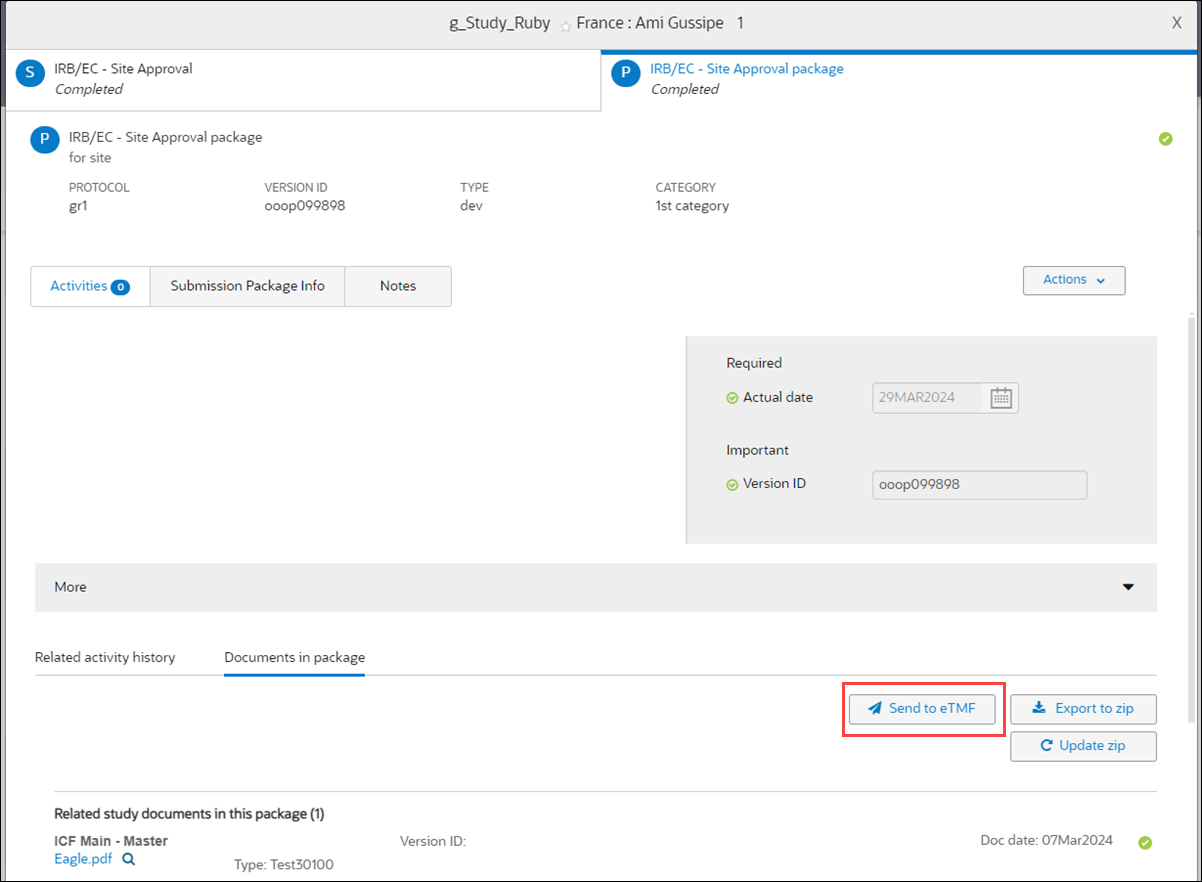Integration
You can publish submission package files to eTMF from within the package if you have a new business role permission, we added a new field in support of Phlex eTMF integration, eTMF publish messages have new fields, and more.
Publish Submission package files to eTMF
New action button on Submission packages
In this release, Oracle Site Activate introduces an enhancement that allows you to trigger sending Submission package documents to an eTMF from within the package itself. When enabled for your organization’s account, and when you have a new business role permission, Enable manual ‘Send to eTMF’ button on Submission packages, you’ll see a new button on Submission packages. The button “Send to eTMF,” will be active only when the submission package is approved. Otherwise, it is inactive (grayed out).
When you click Send to eTMF, Oracle Site Activate sends any files in the submission package to the eTMF endpoint(s) configured for your organization’s account or study. You can click the button only once per package; after you send the files, the button no longer displays, and the text “Sent to eTMF” with the date displays instead. If necessary, you can retry messages on the Event Message page or via API if you have a business role permission that allows you to do so.

New fields in eTMF messages
We also added new fields to the eTMF publish messages that include information about the submission package itself. This additional information ensures the files in each publish message can be stored in the appropriate eTMF location. When you click the new Send to eTMF button in the approved package, the publish message will include a new element, “submission_package,” with the fields below, which will be populated with values where available:
- package_name
- protocol_version (inherited from submission)
- submission_type
- submission_category
- package_version_id
Note that eTMF messages generated outside of the new manual Send to eTMF flow described above will NOT have the submission_package element.
Epic: CHK-43975
Oracle Site Activate-Phlex eTMF integration
With release 24.1, we modified Phlex integration to ensure that items sent from Oracle Site Activate can be filed in the correct folder location in Phlex eTMF. To support this change, Oracle Site Activate now uses the Phlex Reference Code value to help match documents between systems. When triggering an eTMF message to a Phlex endpoint or responding to an Artifact GET, Oracle Site Activate will include the Phlex Reference Code for artifacts to support the integration workflows.
We added Reference Code where necessary to support this enhancement:
- Configuration Designer users will add the Phlex Reference Code in the Customize an Artifact modal using a "Reference Code" field added in this release
- After deploying the configuration, Oracle Site Activate users will see the Reference Code value in the Document modal, TMF Data section banner, as well as in Settings > Processes, when editing an artifact.
- Event Messages will include the reference_code value for eTMF Messages when present
- API users will see the reference_code field in the Artifact GET responses.
Epic: CHK-43975
Publish message file tokens
To ensure customers can access files when necessary, we enhanced outbound publish messages (e.g., eTMF publish) to allow for the regeneration of file access tokens. Publish message file tokens expire after one hour, and you can now generate a new token when needed by retrying the message from either the Event Messages page or via API.
Epic: CHK-43975
API documentation
We updated the What's new section in Oracle Site Activate API documentation to reflect release 24.1 enhancements to the Artifact Publish, Artifacts GET, and eTMF Publish APIs. Because we also updated several existing API documentation sections, we've included a summary of the updates in a Documentation updates table.
Epic: CHK-43975
Parent topic: What's new